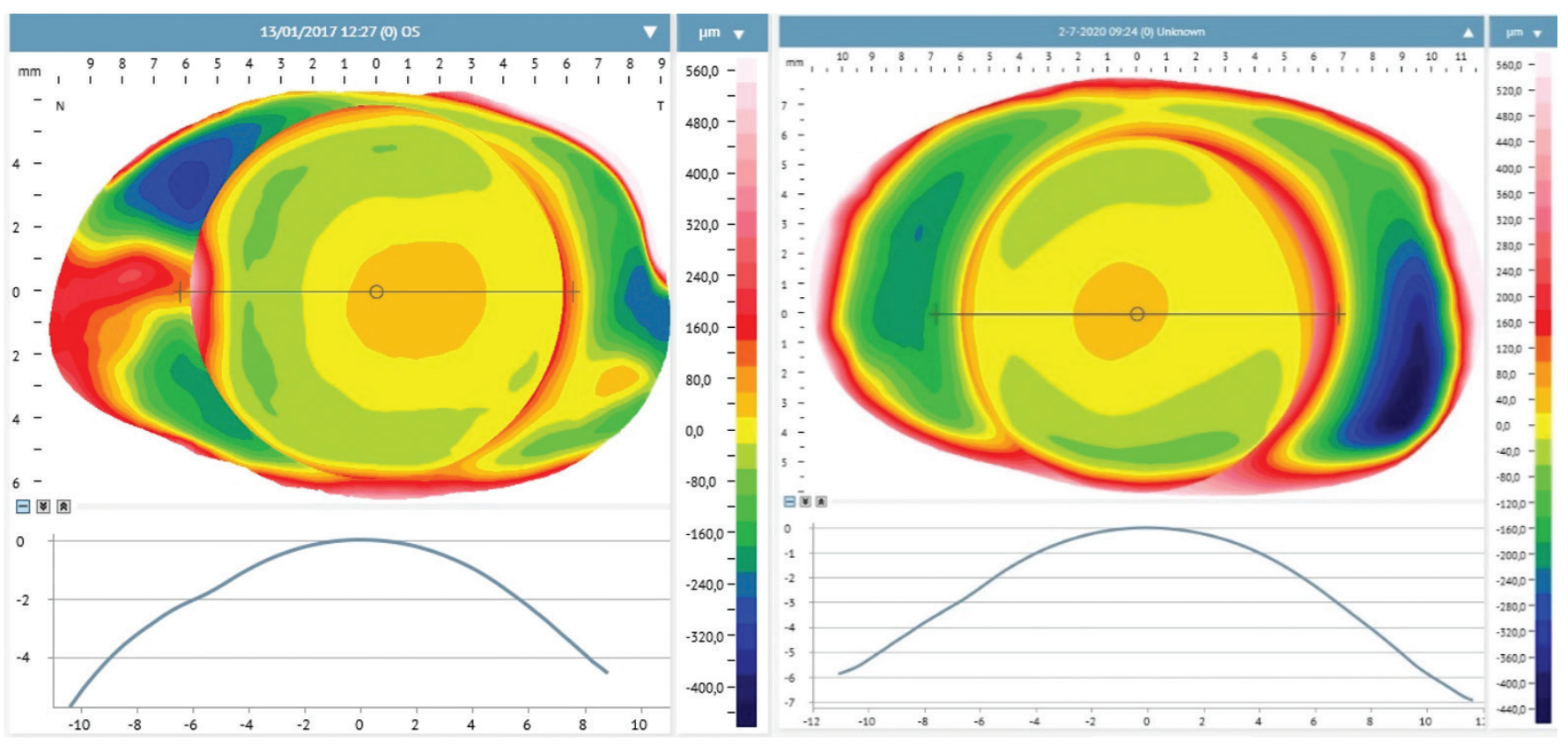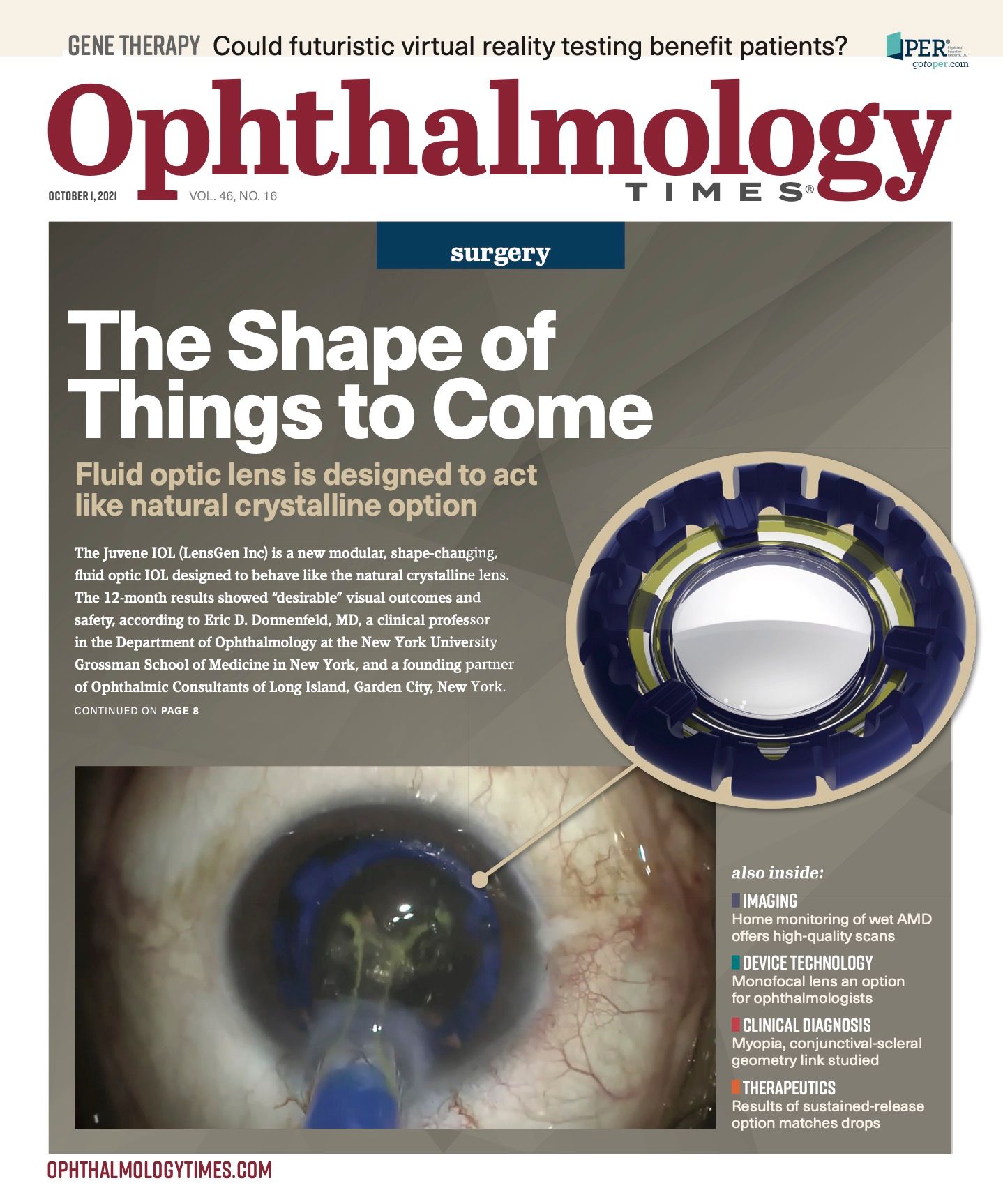Publication
Article
Digital Edition
The relationship between myopia and conjunctival-scleral geometry
Author(s):
Nasotemporal sagittal height asymmetry a good biomarker of shortsightednes.
A bi-sphere corneo-scleral topographic map obtained in an emmetropic eye (left) and a myopic eye (right).
(Images courtesy of Laurent Bataille, PhD; Ainhoa Molina-Martín, PhD; and David P. Piñero, PhD)




Special to Ophthalmology Times®
Myopia is the most common refractive defect of the eye, affecting substantial proportions of adult populations; in one UK study, it was found to affect 49% of adults.1
The exponential increase in the prevalence of the condition is sparking increased interest in the geometric properties of the conjunctival-scleral tissue.
Generally referred to as short sightedness, myopia is an ametropia characterized by an eye that is too long for its optical system (cornea and lens).
In recent years, there has been growing concern about the sharp rise in the prevalence of myopia in the juvenile population, and this has increased the need for research and development of new techniques to control axial elongation of the eye.
Related: Effect of a pressure-free educational system on myopia in Japan
Because in vitro and postmortem studies in humans have shown that the sclera is more extensible in high myopes than emmetropes, and that weakening of the scleral structure is related to the elongation of the eye, in vivo examination of the geometric properties of the anterior sclera in eyes with different levels of myopia may improve our understanding of the variations in the anterior eye properties associated with increased ocular length.2-4
The risk of suffering from diseases such as glaucoma or maculopathies increases very significantly as myopia increases.
Therefore, it is important to understand the weakening procedure that takes place in the sclera, leading to progressive eye elongation, and to see whether this process also generates changes in the anterior portion of the structure (covered by the conjunctiva), which can be measured clinically.
In this way, geometric factors at the level of the sclera might predict which cases are more susceptible to scleral changes.
Considering the existing technology for the clinical evaluation of the corneo-scleral geometry,5 as well as the comparison and validation of the main technologies applied in the clinic,6,7 fourier domain profilometry (Eye Surface Profiler [ESP], Eaglet-Eye) stands out as being a reasonable way of studying the relationship between myopia and corneo-scleral geometry.
Related: Exploring possibilities of myopia prevention and control in the US
Nasotemporal sagittal height asymmetry a good biomarker of shortsightedness
Measurement with this device is minimally invasive and quickly captures all the data necessary to characterize such geometry with high levels of precision.7
Nasotemporal sagittal height asymmetry a good biomarker of shortsightedness
We recently conducted a prospective study to analyze the relationship between corneo-scleral geometry, measured with this type of technology, and the axial length of the eye, defining the differential aspects existing in myopic eyes and developing prediction models of the axial length of the eye based on clinical data.8
Our study
In total, 64 eyes of 32 healthy participants (mean age 33 years) were evaluated in the Optometry Clinic of the University of Alicante, Spain, including complete analysis of the anterior segment, analysis of visual function and evaluation of the corneo-scleral topographic profile with the ESP system.
Related: FDA grants clearance for myopia device
The study methods adhered to the tenets of the Declaration of Helsinki and were approved by the ethics committee of the University of Alicante (Exp UA-2019-08-28).
A statistically significant and moderate-to-strong negative association was found between the axial length and the difference between temporal and nasal sagittal heights for different chord lengths (from r = −0.701; P < 0.001 for 11-mm chord length to r = −0.502; P < 0.001 for 15-mm chord length).
This suggests that nasotemporal sagittal height asymmetry has potential as a biomarker of myopic changes.
It is possible that the decrease in nasotemporal sagittal height asymmetry in myopic eyes is due to different insertion of the medial rectus muscle and the lateral rectus muscle9 combined with the noticeably lower rigidity of the sclera in such eyes.2,10,11
Specifically, there is a rearward displacement of the insertion site of the medial and lateral rectus muscles in myopic eyes,12 with rotation of the eyeball around the same nasal and anterior point to its geometric center regardless of the axial length of the eye.13
Related: Evaluating scleral biomechanics to pinpoint root of accommodation
A multiple linear regression analysis showed that the axial length could be predicted with acceptable levels of precision by means of a linear equation relating refractive, corneal, and corneo-scleral variables, although the variables involved for the prediction seem to differ in right and left eyes.
Specifically, the following linear equations for predicting the axial length (AL) were obtained:
- Right eye (P < .001, adjusted R2: 0.843): AL=15.62-0.27 ×SE+0.99 ×CD+2.77 ×HOA RMS-1.77 ×MinSH14; and
- Left eye (P < 0.001, adjusted R2: 0.730): AL=37.20-0.40 ×SE-0.33 ×Km+0.086 ×CD-3.96 ×HOA RMS where SE is spherical equivalent; CD, corneal diameter; HOA RMS, high order aberration root mean square; MinSH14, minimum sagittal height for a chord length of 14 mm; and Km, mean keratometry.
The slight difference between the linear models used to predict axial length from the anterior segment parameters for the right and left eyes may be related to differences in the ocular globe between eyes:
The asymmetry of the axial length between them has been shown to increase with increasing axial length.14
Related: Scleral melts: Patching ultimately may prove to be unnecessary
These models should be considered as a preliminary approach that provides information on the potential value of the geometry of the anterior sclera for the prediction of axial length.
Future studies should validate and refine these models in large samples including subjects with different ethnicities.
Conclusion
The analysis of the relationship between the corneo-scleral geometry measured with Fourier domain profilometry and the axial length of the eye has shown that nasotemporal sagittal height asymmetry may be a good biomarker of myopic changes.
More studies are needed to clarify this issue as well as determine how these corneo-scleral parameters change during myopia progression.
About the authors
David P. Piñero, PhD
E: david.pinyero@ua.es
Bataille and Molina-Martín are post-doctoral researchers from the Group of Optics and Visual Perception of the Department of Optics, Pharmacology and Anatomy, University of Alicante, Spain. Piñero is a senior researcher and lecturer from the same group and is responsible for the advanced optometry unit of the Department of Ophthalmology of Vithas Medimar International Hospital, Alicante, Spain.
The authors have no proprietary or commercial interest in the medical devices that are mentioned in this manuscript.
--
References
1. Pan CW, Ramamurthy D, Saw SM. Worldwide prevalence and risk factors for myopia. Ophthalmic Physiol Opt. 2012;32(1):3-16. doi:10.1111/j.1475-1313.2011.00884.
2. McBrien NA, Jobling AI, Gentle A. Biomechanics of the sclera in myopia: extracellular and cellular factors. Optom Vis Sci. 2009;86(1):E23-E30. doi:10.1097/OPX.0b013e3181940669
3. Backhouse S, Gentle A. Scleral remodelling in myopia and its manipulation: a review of recent advances in scleral strengthening and myopia control. Ann Eye Sci. 2018;3:1
4. Vurgese S, Panda-Jonas S, Jonas JB. Scleral thickness in human eyes. PLoS One. 2012;7(1):e29692. doi:10.1371/journal.pone.0029692
5. Bataille L, Piñero DP. Characterization of the geometric properties of the sclero-conjunctival structure: a review. Int J Ophthalmol. 2020;13:1484-1492
6. Bataille L, Molina-Martin A, Piñero DP. Comparative analysis of two clinical diagnostic methods of the corneoscleral geometry. Eye Contact Lens. 2021;47(10):546-551. doi:10.1097/ICL.0000000000000785
7. Bataille L, Molina-Martin A, Piñero DP. Intrasession repeatability of corneal, limbal and scleral measurements obtained with a Fourier transform profilometer. Cont Lens Anterior Eye. 2021;44(5):101382. doi:10.1016/j.clae.2020.11.002
8. Bataille L, Molina-Martín A, Piñero DP. Relationship between axial length and corneo-scleral topography: a preliminary study. Diagnostics (Basel). 2021;1(3):542. doi:10.3390/diagnostics11030542
9. Haładaj R. Normal anatomy and anomalies of the rectus extraocular muscles in human: A review of the recent data and findings. Biomed Res Int. 30 Dec 2019. DOI:10.1155/2019/8909162
10. McBrien NA, Gentle A. Role of the sclera in the development and pathological complications of myopia. Prog Retin Eye Res. 2003;22:307-338
11. McMonnies CW. An examination of the relation between intraocular pressure, fundal stretching and myopic pathology. Clin Exp Optom. 2016;99(2):113-119. doi:10.1111/cxo.12302
12. El-Fayoumi D, Bahgat N, Khafagy M, et al. Horizontal extraocular muscle insertion site in relation to axial length using swept-source anterior segment OCT. Clin Ophthalmol. 2020;14:3583-3589
13. Clark RA, Demer JL. The effect of axial length on extraocular muscle leverage. Am J Ophthalmol. 2020;216:186-192. doi:10.1016/j.ajo.2020.03.033
14. Rajan MS, Bunce C, Tuft S. Interocular axial length difference and age-related cataract. J Cataract Refract Surg. 2008;34(1):76-79. doi:10.1016/j.jcrs.2007.08.023

Newsletter
Don’t miss out—get Ophthalmology Times updates on the latest clinical advancements and expert interviews, straight to your inbox.




